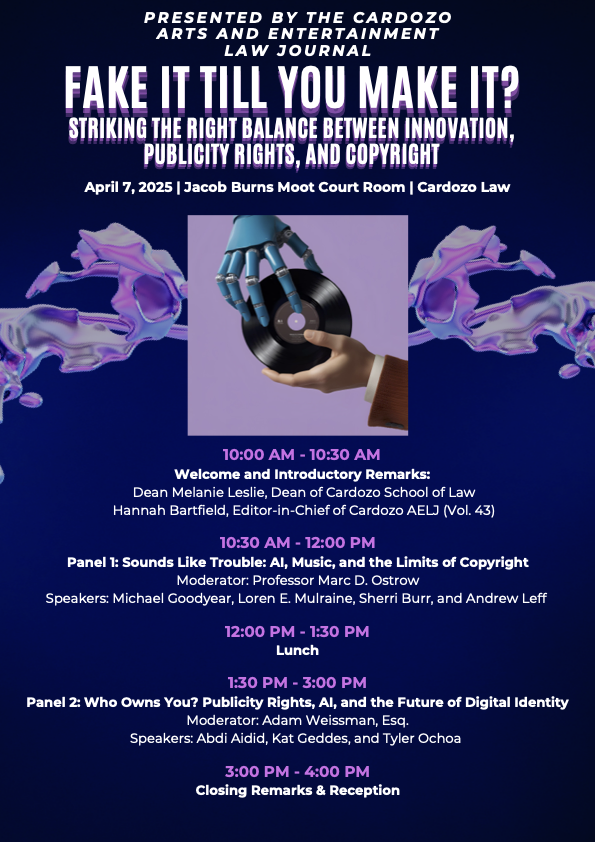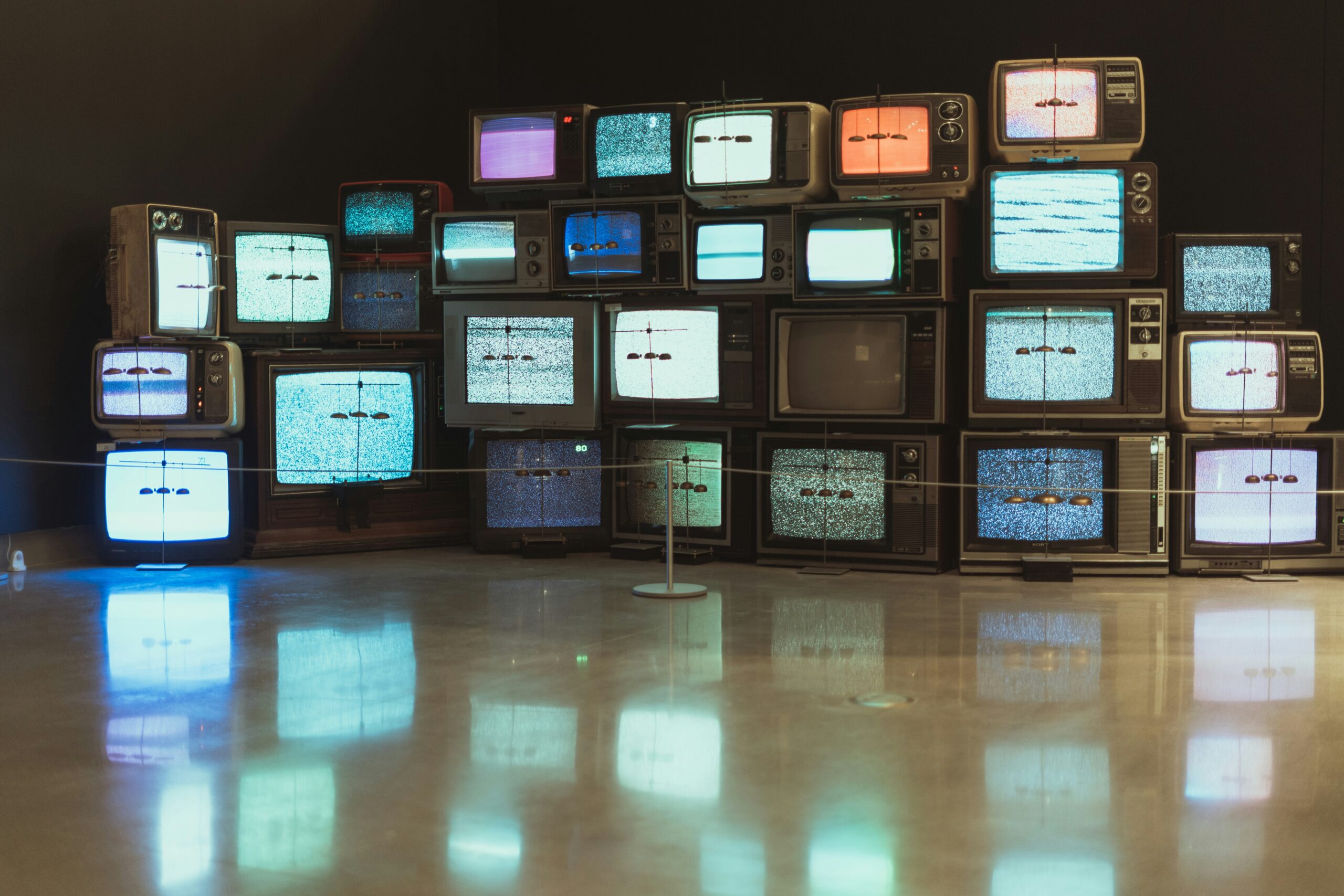Shortly after the first season of the Netflix television show Bridgerton debuted, another project began.1 Struggling musician Abigail Barlow found inspiration in the show, which she felt had an inherent quality that lent itself perfectly to a Broadway-style musical.2 After a clip of herself singing a Bridgerton-inspired song went viral on TikTok, Barlow teamed up with fellow musician Emily Bear, and the work to create a full album based on the show began in earnest.3 Hype continued to build throughout the songwriting process, as Barlow and Bear’s songs amassed roughly thirty-six million likes on TikTok,4 and before long, the album was finished.5 What happened next was unprecedented. The “Unofficial Bridgerton Musical,” already a viral hit, beat out Broadway royalty by winning the Grammy Award for best musical theater album.6 Barlow and Bear followed up their win with a for-profit performance of the album at the Kennedy Center in Washington, D.C.7 But throughout the musical’s successes, many were left questioning: How exactly is this legal?8
As it turns out, it wasn’t, at least in the eyes of Netflix. On July 29, 2022, shortly after the Kennedy Center performance, the streaming giant sued Barlow and Bear for their unlicensed use of the Bridgerton copyright.9 A definitive answer to the musical’s legality was never reached, as the parties settled before litigation began in earnest, leaving unanswered questions about the legal status of the “Unofficial Bridgerton Musical” and other works like it.10
In modern parlance, the “Unofficial Bridgerton Musical” is considered a “fanwork” – a piece of media derived from another person or entity’s preexisting work.11 Fanworks can take a variety of different forms12 and have existed for almost as long as the art of storytelling itself. 13
Interest in and access to fanworks has skyrocketed in the internet era, with everything from dedicated fanfiction websites to more general social media sites (such as Barlow and Baird’s fanwork-delivery method of choice, TikTok) serving to host and promote the work of prospective fan creators.14
The internet’s granting of newfound visibility to fanworks has brought legal challenges to many of fan creators. Many copyright holders prefer to simply issue cease-and-desists to the creators of the infringing fanworks,15 most of whom are ordinary individuals who would rather take down or cease production of their infringing works rather than risk the possibility of costly and complicated intellectual property lawsuits.16 In the rare instances where fanworks have faced formal legal action,17 they have largely been treated as either copies or derivative works18—that is, works based on other, preexisting works.19 Under U.S. copyright law, the only person authorized to make copies and derivative works of a particular work is the work’s copyright holder,20 meaning that most fanworks are inherently in violation of the Copyright Act.21
When faced with claims of copyright violations, fanworks are usually analyzed under the doctrine of “fair use.”22 The Copyright Act provides four main factors for determining fair use: “1) The purpose and character of the use, including whether such use is of a commercial nature . . .; 2) the nature of the copyrighted work; 3) the amount and substantiality of the portion used in relation to the copyrighted work as a whole; and 4) the effect of the use upon the potential market for or value of the copyrighted work.”23
These fair use factors were analyzed in two prominent court cases centering around fanworks, Warner Bros. Entertainment Inc. v. RDR Books and Paramount Pictures Corp. v. Axanar Productions, Inc.24 The court in RDR, a case which concerned the unauthorized publication of a guidebook to the world of Harry Potter,25 focused much of its attention on the third factor, noting the guidebook’s “verbatim copying and close paraphrasing” of the original books’ language.26 Years later, the Axanar court ruled that under the first factor, a Star Trek fan film did not have “a further purpose or different character, altering the [Star Trek copyrighted works] with new expression, meaning, or message.”27 This finding meant that the fan film did not constitute enough of a “transformation” from the official Star Trek franchise to satisfy the first factor of fair use.28 Furthermore, even though the fan film was not being sold for a profit, the court still found that its creators could derive some commercial benefit from it, albeit indirectly, further weakening their case for fair use.29
The settlement between Netflix and Barlow and Baird means that there will be no definitive legal answer as to whether the “Unofficial Bridgerton Musical” constituted fair use. However, in light of RDR and Axanar, it seems unlikely that the defendants would have prevailed with such a defense. As was the case in RDR, the musical not only centered around Bridgerton’s settings and characters, but featured multiple direct quotes and paraphrases of the television show’s dialogue.30 The musical’s concert at the Kennedy Center was for-profit, making the commercial nature of the work even more unambiguous than it was in Axanar.31 While an argument could be made that the addition of music to the storyline of Bridgerton constituted transformation, the combination of the previous factors and the reluctance of the RDR and Axanar courts to find transformation in fanworks renders it doubtful that this factor alone would have saved the musical.32
Ultimately, the fate of the “Unofficial Bridgerton Musical” serves as a reminder that even highly successful and popular fanworks operate on precarious legal grounds, and are usually only permitted so long as the copyright holder chooses to forgo legal action.33 Sometimes, the fanworks go off without a hitch, as was the case with another TikTok musical phenomenon, the “Ratatouille” musical of 2021.34 In this case, the fan musical drew a positive response from copyright holder Disney,35 which many attributed to the musical’s one-time charitable performance in service of actors and stage professionals experiencing difficulty during the Covid-19 pandemic.36 However, Disney’s leniency in this case should be seen as the exception, not the rule. As Netflix stated in their complaint, “[Copyright holders are] not required to sue every infringer” in order to retain the right to put a stop to unauthorized uses of their intellectual property.37 Fanworks can be immensely positive forces for both fans38 and copyright holders,39 and there have been many proposals as to how the law could be changed or adapted to protect fanworks.40 But until such changes are made, prospective fan creators would do well to look to the “Unofficial Bridgerton Musical” as a warning of what happens when fanworks fly too close to the sun.
Madeleine Higgs is a second-year law student at Benjamin N. Cardozo School of Law, and a staff editor at the Cardozo Arts & Entertainment Law Journal. Madeleine is interested in copyright and entertainment law, and all legal matters that govern the creative arts.
- Meilan Solly, What the ‘Unofficial Bridgerton Musical’ Lawsuit Means for Fan-Created Content, Smithsonian Mag. (Aug. 10, 2022), https://www.smithsonianmag.com/smart-news/what-the-unofficial-bridgerton-musical-lawsuit-means-for-fan-created-content-180980566/ [https://perma.cc/9YCP-M3WT]; Julia Jacobs, TikTok to the Grammys: How a ‘Bridgerton’ Musical Beat Broadway, N.Y. Times (Apr. 4, 2022), https://www.nytimes.com/2022/04/04/theater/bridgerton-musical-grammy.html (perma link needed. I cannot add because I’m out of free articles.)
- Nicole Fallert, Meet the Women Behind the TikTok “Bridgerton” Musical Who’ve Now Made Grammy History, Buzzfeed.News (Dec. 17, 2021, 11:52 AM), https://www.buzzfeednews.com/article/nicolefallert/bridgerton-musical-grammy-tiktok-duets [https://perma.cc/SP7Q-VH7S].
- Jacobs, supra note 1.
- Logan Culwell-Block, Netflix Files Suit Against Grammy-Winning Unofficial Bridgerton Musical Writers Abigail Barlow and Emily Bear, Playbill (July 29, 2022), https://playbill.com/article/netflix-files-suit-against-grammy-winning-unofficial-bridgerton-musical-writers-abigail-barlow-and-emily-bear [https://perma.cc/LU4L-NWRS].
- Smith, supra note 4.
- Jazz Tangcay, ‘Unofficial Bridgerton Musical’ Becomes First Grammy-Winning Album to Originate on TikTok, Variety (Apr. 3, 2022, 1:38 PM), https://variety.com/2022/artisans/news/unofficial-bridgerton-musical-tiktok-grammy-1235222248/ [https://perma.cc/2AZN-CCUH].
- Gene Maddaus, Netflix Settles Copyright Lawsuit over “Unofficial Bridgerton Musical,” Variety (Sept. 23, 2022, 6:08 PM), https://variety.com/2022/music/news/netflix-bridgerton-musical-lawsuit-dropped-barlow-bear-1235382454/ [https://perma.cc/ZJ9J-S8T3].
- ICYMI, How Is Tiktok’s Grammy-Winning Bridgerton Musical Legal?, Slate (Apr. 6, 2022, 5:00 AM), https://slate.com/podcasts/icymi/2022/04/unofficial-bridgerton-musical-grammys-win-legal-problems [https://perma.cc/GT84-XALC].
- Solly, supra note 1.
- Maddaus, supra note 7.
- Jane M. Becker, Stories Around the Digital Campfire: Fanfiction and Copyright Law in the Age of the Internet, 14 Conn. Pub. Int. L. J. 133, 136 (2015).
- See Heidi Howard Tandy, Into the Fandom-Verse, 12 No. 1 Landslide 16, 17 (2019) (explaining how fanworks can include everything from recipes to well-funded television shows).
- Jyme Mariani, Lights! Camera! Infringement? Exploring the Boundaries of Whether Fan Films Violate Copyrights, 8 Akron Intell. Prop. J. 117, 120-21 (2015).
- Christina Chung, Note, Holy Fandom, Batman! Commercial Fan Works, Fair Use, and the Economics of Complements and Market Failure, 19 B.U. J. Sci. & Tech. L. 367, 371 (2013); Morgan Drake, “It’s Dead Jim!” – Fair Use in Fanworks Without Precedent, DePaul J. Art, Tech. & Intell. Prop. L. 199, 203-04 (2017); Kagen Despain, Fan Films and Fan Works in the Age of Social Media: How Copyright Owners Are Relying on Private Ordering to Avoid Angering Fans, 2020 B.Y.U. L. Rev. 333, 355 (2020).
- See Mollie E. Nolan, Search for Original Expression: Fan Fiction and the Fair Use Defense, 30 S. Ill. U. L.J. 533, 556-57 (2006) (explaining that issues involving fanworks rarely go to court and how artists and authors like J.K. Rowling and Anne Rice have relied on cease-and-desists to take down fanworks).
- Despain, supra note 14, at 374.
- Kate Romanenkova, The Fandom Problem: A Precarious Intersection of Fanfiction and Copyright, 18 Intell. Prop. L. Bull. 183, 184 (2014) (discussing how there has yet to be a “definitive” fanworks case).
- Steven D. Jamar & Christen B’anca Glenn, When the Author Owns the World: Copyright Issues Arising From Monetizing Fan Fiction, 1 Tex. A&M L. Rev. 959, 971 (2014).
- 17 U.S.C. § 101.
- 17 U.S.C. § 106.
- See Jamar & Glenn, supra note 18, at 971 (“Absent some exception or limitation to the reach of the copyright holder’s rights in the underlying work, the fan fiction author would be an infringer.”).
- Stacey M. Lantagne, Sherlock Holmes and the Case of the Lucrative Fandom: Recognizing the Economic Power of Fanworks and Reimagining Fair Use in Copyright, 21 Mich. Telecomm. & Tech. L. Rev. 263, 265 (2015).
- 17 U.S.C. § 107.
- Warner Bros. Entertainment Inc. v. RDR Books, 575 F. Supp. 2d 513, 539 (S.D.N.Y. 2008); Paramount Pictures Corp. v. Axanar Productions, Inc., No. 2:15-CV-09938-RGK-E, 2017 WL 83506, at *7 (C. D. Cal. Jan. 3, 2017).
- RDR Books, 575 F. Supp. at 521-22.
- Id. at 547.
- Axanar Productions, No. 2:15-CV-09938-RGK-E, 2017 WL 83506, at *7 (quoting Campbell v. Acuff-Rose Music, Inc., 510 U.S. 569, 579 (1994)).
- Id.
- Id. at *8.
- Complaint at 9-13, Netflix v. Barlow, No. 1:22-cv-02247 (D.D.C. July 29, 2022).
- Id. at 1-2.
- Warner Bros. Entertainment Inc. v. RDR Books, 575 F. Supp. 2d 513, 544 (S.D.N.Y. 2008); Axanar, No. 2:15-CV-09938-RGK-E, 2017 WL 83506, at *7.
- See Tandy, supra note 12, at 16 (“These days, companies rarely take fans to court; in recent years, it has generally happened when the fanworks intersect with commerciality in a way that is deemed significant by the copyright holder and/or trademark owner.”).
- Paige V. Gagliardi, TikTok the Musical: Copyright Issues Raised by the “Ratatouille” Musical, 17 Wash. J. L. Tech. & Arts 147, 149 (2022).
- Id. at 159 (“We love when our fans engage with Disney stories. We applaud and thank all online theater makers for helping to benefit [theater-based charity] the Actor’s Fund.”).
- Id. at 165.
- Complaint at 13, Netflix v. Barlow, No. 1:22-cv-02247 (D.D.C. July 29, 2022).
- Betsy Rosenblatt, Belonging as Intellectual Creation, 82 Mo. L. Rev. 91, 95 (2017) (“Fans describe participating in fanwork-creating communities as a sort of ‘savior,’ providing them with community, empowerment, and an enhanced sense of self.”).
- See Despain, supra note 14, at 340 (discussing rightsholders’ interests in increasing profits through encouraging fan participation).
- For discussions on ways to protect fanworks, see Rachel Morgan, Note, Conventional Protections for Commercial Fan Art Under the U.S. Copyright Act, 31 Fordham Intell. Prop. Media & Ent. L. J. 514 (2021); Romanenkova, supra note 17.



